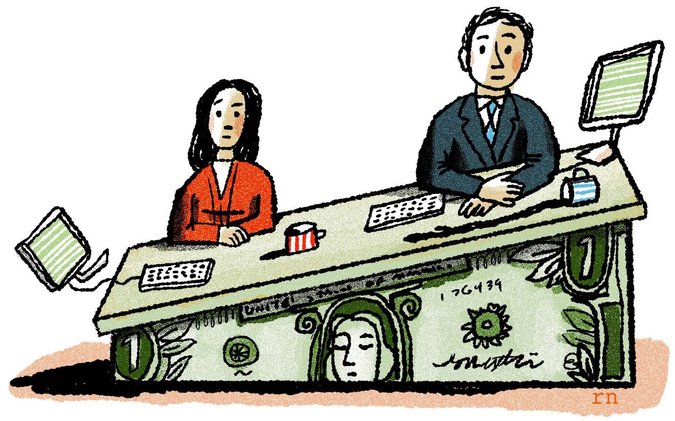
Women’s median annual earnings stubbornly remain about 20 percent below men’s. Why is progress stalling? It may come down to this troubling reality, new research suggests: Work done by women simply isn’t valued as highly.
That sounds like a truism, but the academic work behind it helps explain the pay gap’s persistence even as the factors long thought to cause it have disappeared. Women, for example, are now better educated than men, have nearly as much work experience and are equally likely to pursue many high-paying careers. No longer can the gap be dismissed with pat observations that women outnumber men in lower-paying jobs like teaching and social work.
A new study from researchers at Cornell University found that the difference between the occupations and industries in which men and women work has recently become the single largest cause of the gender pay gap, accounting for more than half of it. In fact, another study shows, when women enter fields in greater numbers, pay declines — for the very same jobs that more men were doing before.
Consider the discrepancies in jobs requiring similar education and responsibility, or similar skills, but divided by gender. The median earnings of information technology managers (mostly men) are 27 percent higher than human resources managers (mostly women), according to Bureau of Labor Statistics data. At the other end of the wage spectrum, janitors (usually men) earn 22 percent more than maids and housecleaners (usually women).
Once women start doing a job, “It just doesn’t look like it’s as important to the bottom line or requires as much skill,” said Paula England, a sociology professor at New York University. “Gender bias sneaks into those decisions.”
She is a co-author of one of the most comprehensive studies of the phenomenon, using United States census data from 1950 to 2000, when the share of women increased in many jobs. The study, which she conducted with Asaf Levanon, of the University of Haifa in Israel, and Paul Allison of the University of Pennsylvania, found that when women moved into occupations in large numbers, those jobs began paying less even after controlling for education, work experience, skills, race and geography.
And there was substantial evidence that employers placed a lower value on work done by women. “It’s not that women are always picking lesser things in terms of skill and importance,” Ms. England said. “It’s just that the employers are deciding to pay it less.”
A striking example is to be found in the field of recreation — working in parks or leading camps — which went from predominantly male to female from 1950 to 2000. Median hourly wages in this field declined 57 percentage points, accounting for the change in the value of the dollar, according to a complex formula used by Professor Levanon. The job of ticket agent also went from mainly male to female during this period, and wages dropped 43 percentage points.
The same thing happened when women in large numbers became designers (wages fell 34 percentage points), housekeepers (wages fell 21 percentage points) and biologists (wages fell 18 percentage points). The reverse was true when a job attracted more men. Computer programming, for instance, used to be a relatively menial role done by women. But when male programmers began to outnumber female ones, the job began paying more and gained prestige.
While the pay gap has been closing, it remains wide. Over all, in fields where men are the majority, the median pay is $962 a week — 21 percent higher than in occupations with a majority of women, according to another new study, published Friday by Third Way, a research group that aims to advance centrist policy ideas.
Today, differences in the type of work men and women do account for 51 percent of the pay gap, a larger portion than in 1980, according to definitive new research by Francine D. Blau and Lawrence M. Kahn, economists at Cornell.
Women have moved into historically male jobs much more in white-collar fields than in blue-collar ones. Yet the gender pay gap is largest in higher-paying white-collar jobs, Ms. Blau and Mr. Kahn found. One reason for this may be that these jobs demand longer and less flexible hours, and research has shown that workers are disproportionately penalized for wanting flexibility.
Of the 30 highest-paying jobs, including chief executive, architect and computer engineer, 26 are male-dominated, according to Labor Department data analyzed by Emily Liner, the author of the Third Way report. Of the 30 lowest-paying ones, including food server, housekeeper and child-care worker, 23 are female dominated.
Many differences that contributed to the pay gap have diminished or disappeared since the 1980s, of course. Women over all now obtain more education than men and have almost as much work experience. Women moved from clerical to managerial jobs and became slightly more likely than men to be union members. Both of these changes helped improve wage parity, Ms. Blau’s and Mr. Kahn’s research said.
Yes, women sometimes voluntarily choose lower-paying occupations because they are drawn to work that happens to pay less, like caregiving or nonprofit jobs, or because they want less demanding jobs because they have more family responsibilities outside of work. But many social scientists say there are other factors that are often hard to quantify, like gender bias and social pressure, that bring down wages for women’s work.
Ms. England, in other research, has found that any occupation that involves caregiving, like nursing or preschool teaching, pays less, even after controlling for the disproportionate share of female workers.
After sifting through the data, Ms. Blau and Mr. Kahn concluded that pure discrimination may account for 9 percent of the gender pay gap. Discrimination could also indirectly cause an even larger portion of the pay gap, they said, for instance, by discouraging women from pursuing high-paying, male-dominated careers in the first place.
“Some of it undoubtedly does represent the preferences of women, either for particular job types or some flexibility, but there could be barriers to entry for women and these could be very subtle,” Ms. Blau said. “It could be because the very culture and male dominance of the occupation acts as a deterrent.”
For example, social factors may be inducing more women than men to choose lower-paying but geographically flexible jobs, she and Mr. Kahn found. Even though dual-career marriages are now the norm, couples are more likely to choose their location based on the man’s job, since men earn more. This factor is both a response to and cause of the gender pay gap.
Some explanations for the pay gap cut both ways. One intriguing issue is the gender difference in noncognitive skills. Men are often said to be more competitive and self-confident than women, and according to this logic, they might be more inclined to pursue highly competitive jobs.
But Ms. Blau warned that it is impossible to separate nature from nurture. And there is evidence that noncognitive skills, like collaboration and openness to compromise, are benefiting women in today’s labor market. Occupations that require such skills have expanded much more than others since 1980, according to research by David J. Deming at Harvard University. And women seem to have taken more advantage of these job opportunities than men.
Still, even when women join men in the same fields, the pay gap remains. Men and women are paid differently not just when they do different jobs but also when they do the same work. Research by Claudia Goldin, a Harvard economist, has found that a pay gap persists within occupations. Female physicians, for instance, earn 71 percent of what male physicians earn, and lawyers earn 82 percent.
It happens across professions: This month, the union that represents Dow Jones journalists announced that its female members working full time at Dow Jones publications made 87 cents for every dollar earned by their full-time male colleagues.
Colleen Schwartz, a Dow Jones spokeswoman said, “We remain absolutely committed to fostering an inclusive work environment.”
Certain policies have been found to help close the remaining occupational pay gap, including raising the minimum wage, since more women work at the lowest end of the pay scale. Paid family leave helps, too.
Another idea, Ms. Liner of Third Way said, is to give priority to people’s talents and interests when choosing careers, even if it means going outside gender norms, for instance, encouraging girls to be engineers and boys to be teachers. “There’s nothing stopping men and women from switching roles and being a maid versus a janitor except for social constructs,” she said.
3 WAYS TO SHOW YOUR SUPPORT
- Log in to post comments












